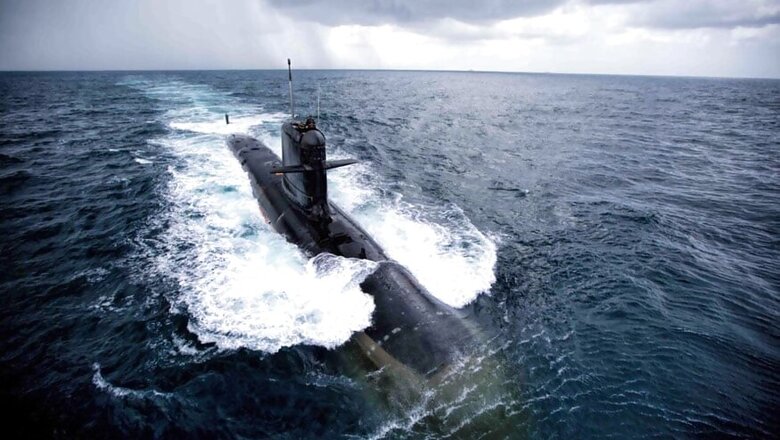
views
Prime Minister Narendra Modi has commissioned the first of the six Scorpène-class submarines into the Indian Navy. INS Kalvari, named after the deep-sea Tiger Shark in Malayalam, representing agility, strength and predatory prowess, carries the motto ‘Ever Onwards’. While the metaphoric value attached to the INS Kalvari seems impressive on many levels, what is even more intimidating is the fact that the submarine reflects India’s progress towards the ‘Make-in-India’ initiative. The INS Kalvari has been manufactured in Mumbai by Mazagon Dockyard Limited (MDL), building upon the design of DCNS – a French naval defence and energy company. The entire project is a result of more than 12 years of planning and execution to strengthen Indian Navy’s presence below the sea waters. Incidentally, the INS Kalvari has been named after the very first submarine acquired by the Indian Navy way back on December 8, 1967, which successfully proved its worth during the Indo-Pak war in 1971 by having the desired discouraging effect on the enemy while stationed in the Bay of Bengal and the Arabian Sea.
When in 2005 the Indian government planned for a replacement of then prevailing Kilo-class (Sindhughosh Class – as dubbed by the Indian Navy) submarines, a choice had to be made between the Scorpène design by the French and the type 214 design by the Germans. The Indian Navy then opted for the Scorpène, owing to its capability to fire Exocet or Anti-ship missiles. The US$3 Billion deal was based on a technology transfer agreement, providing state-owned MDL the manufacturing rights for six such submarines. In addition, an agreement was made to implant the last two submarines with an Air Independent Propulsion system designed by DRDO. The system is aimed to allow the diesel-engine submarines to operate without the presence of atmospheric oxygen. Even though the first of the six, the INS Kalvari experienced a delay of more than four years in its induction, with the first proposed induction date being in 2012. After more than a year of sea trials, including the firing of a torpedo and an anti-ship missile, the submarine came under the acquisition of the Indian Navy on September 21 2017.
As for its purpose of existence, the INS Kalvari is a stealth-attack submarine, powered by a diesel-electric engine and capable of indulging in all types of naval warfare. One major advantage that the diesel engine submarines have over the nuclear-powered ones is that they produce less noise underwater, giving them an edge in stealth operations. In addition to this, the INS Kalvari appoints advanced acoustic silencing technique, which dampens the vibrations produced by the submarine, making it even more difficult to be detected by Sonar. Even the equipment inside the pressure hull of the INS Kalvari is mounted on shock absorbing cradles for enhanced stealth. All in all, it would take technology of the highest order, currently available only to a handful of countries, to detect an INS Kalvari moving in their waters.
That being said, the Kalvari is not just made for gliding undetected underwater. It is also an offensive entity of the highest order, capable of carrying 18 heavyweight wire guided Surface and Underwater Target (SUT) torpedoes, housed in 6 torpedo tubes. As an alternative, the submarine can carry SM-39 Exocet ‘anti-ship’ missiles and 30 mines. The Kalvari class also comes equipped with mobile C303/S, anti-torpedo decoys that misguide an enemy torpedo away from the submarine in case of an attack. In exchange, the INS Kalvari uses precision-guided missiles for sinking the enemy vessel. Adding to the lethality of a Kalvari’s attack is the Submarine Tactical Integrated Combat System (SUBTICS), designed by the DCNS, which essentially optimizes every sensor and weapon capability to enhance operational efficiency (such as detecting targets and deciding torpedo projectiles for maximum impact). INS Kalvari is also able to detect and classify the type of vessel over large distances through the embedded LOFAR (Low-Frequency Analysis and Ranging) Sonar System. In addition, its attack and search periscopes are equipped with laser range finders and infrared/low light level cameras for enabling attacks on the sea surface.
All this firepower and stealth technology enable the INS Kalvari to be an effective player in anti-submarine warfare, anti-surface warfare, intelligence gathering, mine laying as well as area surveillance.
As for its technicalities, the INS Kalvari weighs 1,565 tonnes and is capable of reaching speeds of up to 20 knots (37 km/h) while submerged under water. The 221 feet long submarine boasts of a range of 6,500 nautical miles on the surface and 550 nautical miles when submerged. The two 1250 kW MAN Diesel Engines of the submarine run to charge its batteries rapidly. 360 battery cells, weighing 750 kg each, are used to power the Permanently Magnetised Propulsion Motor of the submarine.
After a gap of more than 17 years, INS Kalvari is the first conventional (non-nuclear) submarine to be inducted into the Indian Navy. With the Indian Navy’s submarine division celebrating its golden jubilee this year, the INS Kalvari is a technological marvel on many fronts and will certainly pave the way for India’s defence prowess even under water.




















Comments
0 comment